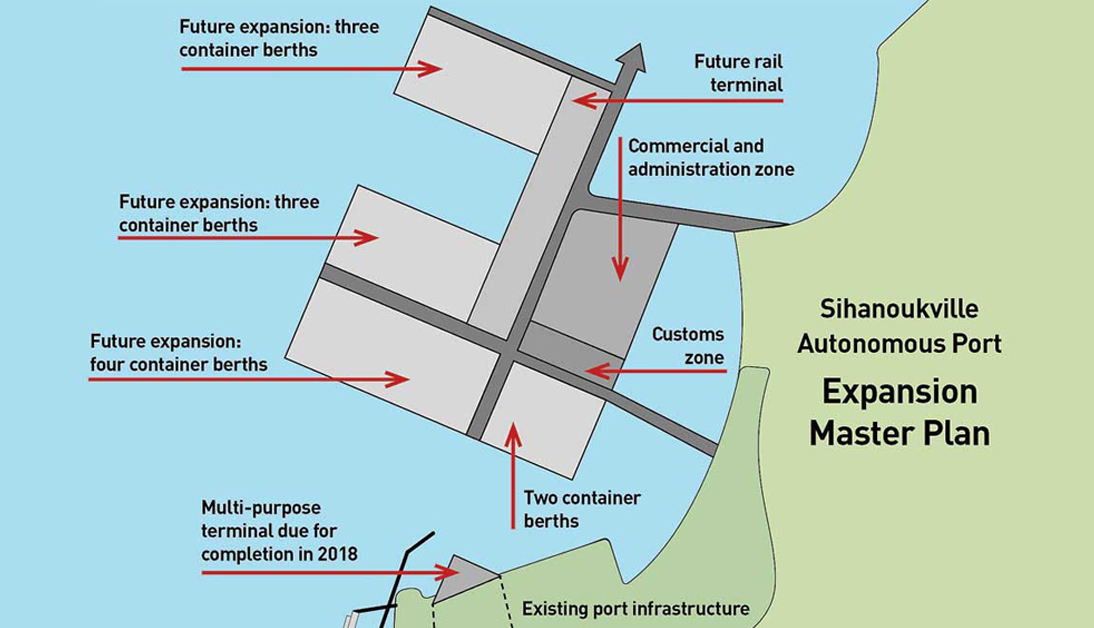
The conceptual plan for the $300 million expansion of the Sihanoukville Autonomous Port, which was announced this week. Infographic based on information from the Sihanoukville Autonomous Port.
A massive $300 million expansion of the Kingdom’s principal seaport announced this week will significantly improve supply chain logistics, reduce transport costs, and increase the competitiveness of Cambodian goods in international markets, private sector leaders said yesterday.
Sin Chanthy, president of the Cambodia Freight Forwarders Association (CAMFFA), said the government’s plan to expand Sihanoukville Autonomous Port (SAP) will improve the seaport’s handling capacity, reducing both the time and cost of import and export shipments.
“We welcome this expansion plan for Sihanoukville’s port as once it’s completed we’ll realise huge benefits, especially in our ability to compete on cost for both imports and exports.”
The ambitious port development plan, revealed during the annual meeting of the Ministry of Commerce on Wednesday, envisions the construction of a new container port – comprising a terminal, container yard, and customs and administrative buildings – on reclaimed land just north of the existing port facility.
The new port’s terminal will extend over 350 metres in length with a draft of 14.5 metres, capable of handling large container ships. Its container berths and storage yard will add 1 million TEU, or 20-foot equivalent units, of container throughput capacity, effectively tripling SAP’s current capacity.
Future expansion, to be built on more reclaimed land, would include additional container berths and a rail terminal.
Va Sim Soriya, spokesman of the Ministry of Transport and Public Works, said construction of the new container terminal was expected to begin next year and finish by 2022 at a total cost of $300 million. He said the expansion, part of the government’s national development plan, would play a crucial role in promoting Cambodia’s economic growth.
“Currently we are only able to handle small ships, so we need to transfer cargo shipments onto big ships at neighbouring ports, which costs a lot,” he said. “The port expansion will play an important role in facilitating import and export shipments, and will reduce the cost of logistics, making us competitive with the international market.”
Soriya said once completed, the new terminal will be able to handle 1 million TEU of containers and 10 million tonnes of cargo a year. And with its 14.5-meter draft, more than 90 percent of the international ships operating in the region will be able to dock, reducing the need for transshipment and benefitting from economies of scale.
According to Soriya, the government is currently looking to secure funding for the project from the Japanese government or its foreign development agency.
In a separate project, Japan International Cooperation Agency has provided a $74 million soft loan to build a new multipurpose terminal at SAP capable of increasing its total handling capacity to 700,000 TEU, from about 500,000 TEU today. The new terminal, which will increase the port’s draft from 8.5 metres to 13.5 metres and has special facilities to handle oil and agricultural shipments, is expected to be finished in 2018.
Chanthy, whose own logistics company regularly uses Sihanoukville’s port, said the port expansion projects will free up the bottlenecks that result in costly shipping delays.
“The existing terminal is constrictive,” he said. “Space is limited and we cannot just receive incoming ships whenever we want. Ships have to wait out at sea for the next available berth.”
Reflecting on his experiences exporting lift-on lift-off shipments of dried cassava, Chanthy said his company was usually given only a short window to load the shipment then forced to pay hefty fees for additional time.
“When I export cassava to China space is limited so I have to pay for additional berthing time, which quickly racks up the cost,” he said, adding that an 8,000-tonne ship typically pays $1,000 for every extra day it berths.
Hun Lak, vice president of the Cambodia Rice Federation, and CEO of Mekong Oryza Trading Co, said the expansion of Sihanoukville’s port was an effective strategy to reduce the high logistics costs that are hampering the ability of Cambodian rice exporters to compete in international markets.
“Port capacity is closely linked to the cost of logistics, which is one of the main issues we face in promoting rice exports as compared to neighbouring countries our logistics costs are high, so it’s very hard for us to compete,” he said. “The port’s expansions should reduce these costs and we’re eager to see how this will help our rice sector.”
Ministry of Transport data released this week projected that throughput at SAP, which handles over 65 percent of Cambodia’s container shipments, would top 399,000 TEU in 2016, a two-percent increase over 2015. The port is expected to handle more than 1 million TEU of container shipments per year from 2023.
Contact PhnomPenh Post for full article
Post Media Co LtdThe Elements Condominium, Level 7
Hun Sen Boulevard
Phum Tuol Roka III
Sangkat Chak Angre Krom, Khan Meanchey
12353 Phnom Penh
Cambodia
Telegram: 092 555 741
Email: [email protected]












